The graphics arm of AMD, what we once called ATI, is clearly on the rebound. Alex Herrera takes a close look at their newest professional graphics processing units.
By Alex Herrera
AMD’s Cayman GPU has joined the professional ranks of the FirePro family, providing the company a powerful new weapon in its fight with its only real rival, market leader Nvidia. Cayman made its professional debut when AMD introduced two FirePro cards in May of 2011: the $999 MSRP V7900 and its more modest sibling, the $599 V5900. AMD slots the latter in its Mid-range and the former in its High End (though with its sub-$800 street price, it is by our definitions also a Mid-range card).
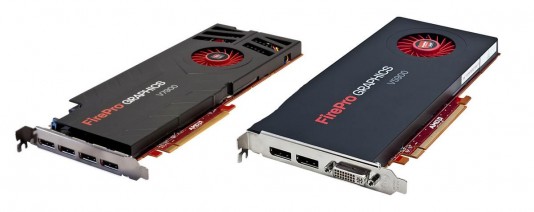
Both come configured with 2 GB of GDDR5 memory and both are built around the Cayman LE GPU. The V7900 exploits every single one of the architecture’s 1,280 stream processors (in AMD parlance really more like ALU’s), while AMD enables 512 for the V5900. The similarities for the most part end there, as we see major performance, power and feature enhancements jumping up from the V5900 to the V7900.

The memory clock for the V7900’s is cranked up to yield 160 GB/sec of maximum bandwidth, while the V5900’s is dialed back to offer 64 GB/sec (half the width of the memory interface, we’d presume). The V7900 integrates four DisplayPort outputs to enable four independent high-res displays, where the V5900’s two DisplayPort and one dual-link DVI interfaces can drive three. The V7900 supports both the S400 framelock/genlock daughter card and stereo 3D, while the V5900 supports neither.
Delivering higher performance, the V7900 requires two PCI Express slots and consumes a respectable 150 Watts, while the svelte V5900 fits in a single slot and operates within an impressive 75 W power envelope.
As of this writing, Dell had picked up both new cards for its Precision line. We imagine Lenovo, Fujitsu and HP will also offer one or both, possibly waiting until the mid-range refresh later in 2011 with Sandy Bridge-EP.
Overview of the Cayman architecture
Well before AMD’s Evergreen GPU family was peaking, AMD was already at work with the next planned generation. After all, both Nvidia and AMD always have another generation planned. In some cases, the new generation is the culmination of several years of development, overhauling previous architectures with a new approach.
But to maximize the return on its investments, semiconductor suppliers in general—and GPU vendors in particular—often like to insert more modest mid-life kickers in-between the major new generations of a product line. Sometimes the kicker will focus on cost effectiveness, coming up with a smaller die via process shrink or refined layout. And sometimes the kicker will stick with the old process and rely on design optimizations and modest feature improvements.
With its follow-up to Evergreen, a family introduced in Q4’10 under the Radeon brand and internally code-named “Northern Islands,” AMD chose a combination of approaches. With its mid-range Barts GPU the company focused more on cost reducing Evergreen, introducing more modest feature enhancements. But with its high-end Cayman, the company still heavily leveraged Evergreen technology, but more aggressively reworked pieces of the GPU architecture.

Appearing first as the Radeon HD 6900 family in December of 2010, Northern Islands single-chip flagship GPU Cayman exploits Barts’ optimizations but does so on a larger scale—with more significant architectural enhancements—to effectively fill AMD’s upper tier of graphics products. Within the Northern Islands family, Cayman preceded dual-chip Antilles and intentionally leapfrogged Barts.
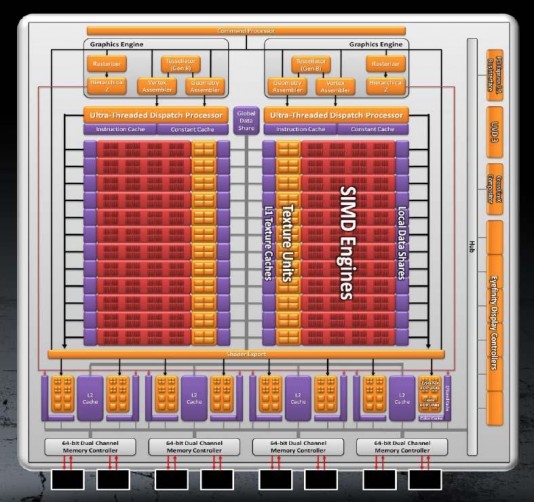
As with Barts, Cayman is strongly derived from Evergreen, with some of the same—as well as a few key additional—enhancements, most notably:
- More on-chip resources, especially dual Graphics Engines
- VLIW4 core architecture, rather than Evergreen’s VLIW5
- Upgrades to ease and speed GPU compute applications, most notably asynchronous dispatch
- Enhanced modes for existing anti-aliasing techniques, as well as a new approach with Morphological AA
For a thorough examination of each of these architectural enhancements, refer to the AMD Graphics chapter of the JPR Workstation Report, Semi-annual Edition. As of this writing, only Cayman has appeared bearing the FirePro brand, with the summer launch of the V7900 and V5900. While not impossible, we don’t expect to see Barts join the FirePro family. However, we eventually expect to see Antilles top out the family with a V9800 follow-on.
Benchmarking the FirePro V7900 and V5900
With particular strengths in price-performance and performance-per-watt, the two latest FirePro cards now occupy the mid-range and high-end positions in AMD’s workstation graphics portfolio. AMD has provided us with both new models to evaluate just how competitive they are going to be.
To get a sense of the performance these two can deliver, we employed some of the same basic tools we have in the past, as well as one very welcome new addition. We tapped SPEC’s Viewperf to isolate the stress on the graphics cards, and we use SPECapc, Cadalyst and Cinebench tests to get a handle on how well the cards support whole-system performance. Choosing among the SPECapc suite of benchmarks, we chose Lightwave and 3ds max, representing two popular applications used in digital content creation (DCC) and CAD.
The latter was especially useful, as the latest version, SPECapc for 3ds max 2011 has been updated. Improvements include new models and test cases, a cleaner and enhanced user interface, and most importantly, compatibility with more recent versions of both 3ds max (2011) and Windows (both 32 and 64-bit Windows 7).
Our Z800 test bench
Thanks to HP, we’ve got an impressive test bench for professional graphics cards. The company was kind enough to equip us with their top-end Z800, capable of driving up to four PCI Express cards at once. With a 6-core Intel Xeon X5670 CPU (Westmere generation) running at 2.93 GHz, paired with 12 GB of 1333 MHz DDR3 memory, our Z800 provides a powerful and consistent foundation upon which to assess the performance of these and other workstation-caliber cards.
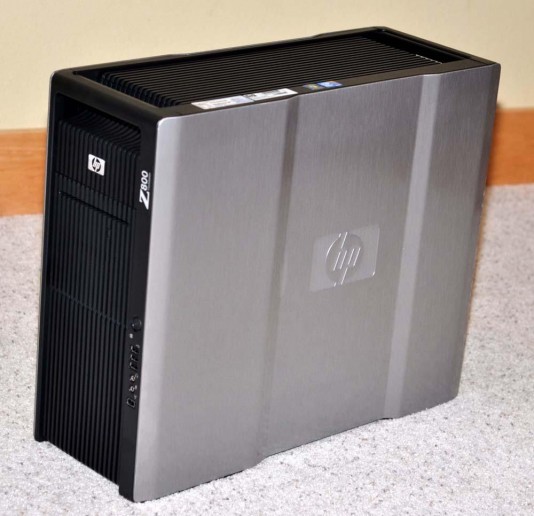
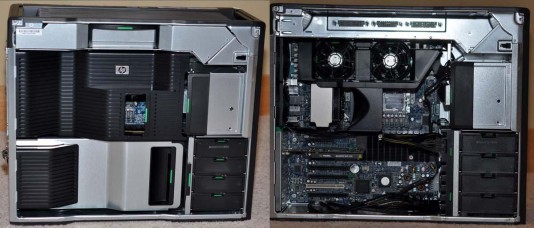

Viewperf 11
First up was Viewperf 11, the most recent revision of the long-time graphics benchmark. A nice step up from Viewperf 10, this version thankfully does away with the multitude of confusing options on running the benchmark and in their place is a simple dialog box that allows you to select resolution and number of iterations. Simple. Thank you, SPEC.
We separately installed and ran both cards on the Z800, making sure to download the latest-and-greatest drivers from AMD’s support site. Where 1280 x 1024 used to be a reasonable common denominator for setting resolution, we’re now pushing to 1920 x 1080, as the resolution is now generally pervasive and supported by most moderately priced monitors. We ran Viewperf 11 with three iterations.
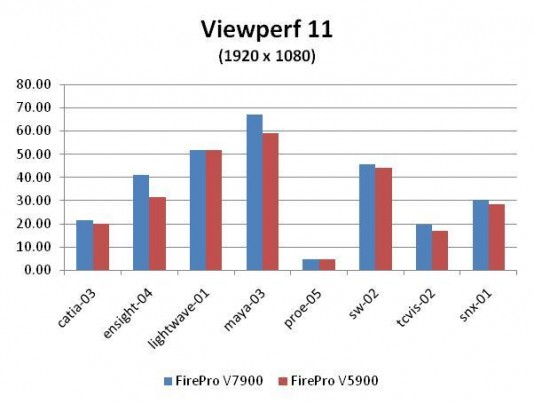
Not surprisingly, the V7900 bested the V5900 consistently, though to varying degrees. The V7900 managed a 31% margin on one viewset (ensight-04) but essentially none on two other (lightwave-01 and proe-05). On average, the V7900 was just around 10% faster. Differences in margins are understandable, given differences in viewsets. For examples, when rendering primitives which are I/O bound (unlikely) or memory bound (quite possibly), a faster GPU engine isn’t going to help. But conversely, in cases where the bottleneck is in shader computation, then the advantages of the faster GPU will show through. The differences in results reflect just that, both in Viewperf as well as the various sub-metrics in whole-system benchmarks SPECapc, Cadalyst and Cinebench (just ahead).
Similarly, the results for the V5900 and V7900 compared to other in-the-price-neighborhood cards with results submitted to SPEC (e.g. Nvidia’s Quadro 2000 and Quadro 4000, respectively) were also highly varying. With some viewsets (e.g. lightwave), the cards all performed similarly. However, in some viewsets (e.g. ensight, tcvis) the AMD cards bested their rivals substantially, while in others (e.g. Catia, Pro/Engineer), they lagged far behind. While difficult to compare overall, it appears the AMD cards are on relatively equal footing with their rival’s price-comparable SKUs.

SPECapc: Lightwave and 3ds max 2011
To evaluate overall system performance, we had the opportunity to exercise two SPECapc tests, for 3ds max and Lightwave. While 3ds max is increasingly used in CAD spaces like architecture, engineering and construction (AEC), both have primarily been used by digital content. As mentioned previously, we had the pleasure of trying out the new SPECapc for 3ds max 2011, which makes testing less error-prone. It’s now easier to use and more compatible with newer systems.
Now with SPECapc, neither the graphics nor the rest of the system are solely responsible for scores. Rather, it’s the sum of the parts that are being tested, to try to give an idea of how the system might perform in a real-world environment. Where GPU-accelerated rendering is the bottleneck, throughput will vary by graphics card. But where it’s not (CPU, memory or I/O limitations), the test won’t show a difference. Average it all out, and the differences in results for whole-system type tests like these come in lower than for Viewperf.
Sure enough, for sub-tests like the Render and Multi-task components of SPECapc Lightwave and the CPU Render component of SPECapc 3ds max, the results for both cards were nearly identical. All of these tend to stress the CPU more than the GPU (ironic for something named “Render”, but in these cases the tests are rendering in software, not via hardware-accelerated APIs like OpenGL or DirectX).
But for components which do stress the GPU, like SPECapc Lightwave’s Interactive (4.1% faster) and SPECapc 3ds max’s Graphics (+10.4%) and Hardware Shaders (+13.3%), the V7900 has the clear edge—as expected, not as dramatic an edge as it has in some Viewperf tests, but an edge nonetheless.
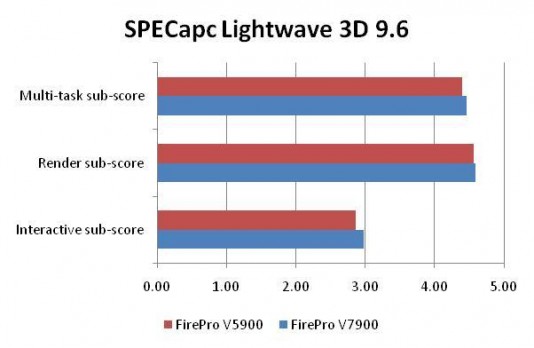

Cadalyst
The CAD space represents the largest chunk of workstation and professional graphics users. But while 3ds max gets a share of work in CAD as well as DCC, there’s one application that dominates the former space: AutoCAD. And when it comes to getting a feel on how well a card or system can handle AutoCAD, we fortunately still have the mainstay Cadalyst benchmark, now updated to 2011.

Results from the Cadalyst 2011 tests are consistent with SPECapc. The more the test relies on the GPU, the bigger the performance delta (+6.5% for 3D Graphics and +2.4% for Total). And the less it relies on GPU horsepower (CPU or memory bound), the less of a difference (+0.4% for 2D).
Cinebench
Last but not least, we have Cinebench, a benchmark which renders a 3D sequence (currently, a car chase through town) utilizing both CPU and GPU resources. It reports a composite performance number for both CPU (CPU) and graphics (OpenGL). Since we’re benchmarking graphics cards, and comparing two cards on the same Z800 test bench, we focus on the OpenGL component.
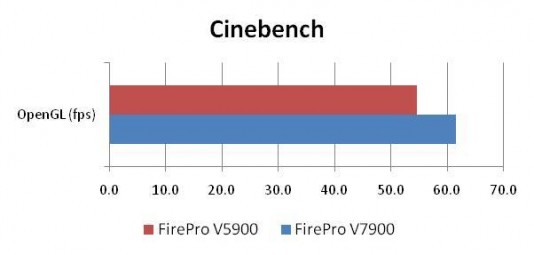
What you get moving from the V5900 up to the V7900
Of interest to both a graphics card supplier and its customers is how products in the vendor’s portfolio are positioned with respect to one another. The customer of course cares, in order to best assess price/performance and—ultimately—return on investment (ROI). There’s no point spending more to get a trivial return, or even no return at all. And accordingly, the vendor cares, because it’s got to show customers—especially the biggest ones, the workstation OEMs—that there’s a sensible progression of performance and capability as one meanders up the product line.
So how well overall does the V7900 demonstrate superiority over its less expensive sibling, the V5900? Well, as we’d expect, it’s never materially slower, but its performance advantage varies by benchmark and component within the benchmark.
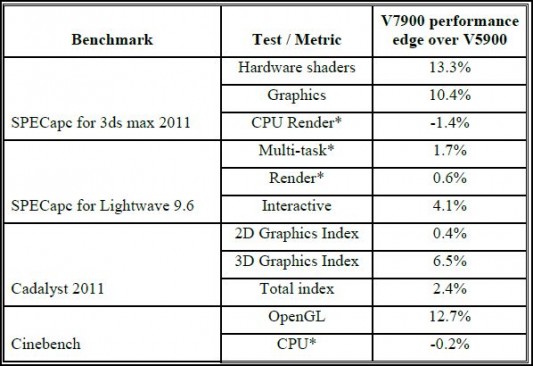
Now these speedup numbers beg an obvious question: why pay more for the V7900 when in some cases the benchmark suggests little to no benefit? For example, if Cadalyst is a reasonable indicator of real-world AutoCAD performance, is a 2.4% speed-up worth spending around $400 more for the V7900? Maybe for some, but for most probably not. And then isn’t that a problem for AMD’s marketing and positioning?
Well, not really. Yes, the Cadalyst results would indicate to an AutoCAD professional that the V5900 is a better price/performer, and almost a similar performer outright. But that’s not necessarily a problem, because we highly doubt AMD is thinking about the AutoCAD crowd with the V7900. Both AMD and Nvidia tend to push the lower half of their product lines more toward that user base. So AMD is likely just fine with AutoCAD users opting for the V5900.
But what about the other benchmarks based on 3ds max and Lightwave, as well as Cinebench, which strive to measure performance for applications and test cases that a mid-range or high-end graphics card buyer would most certainly be interested in? For those results we see a dichotomy of numbers, ones in which the V7900 is not significantly faster, for components likely constrained heavily by non-GPU resources.
On the other hand, when we focus on those components which are more directly influenced by the GPU, for example 3D graphics indices, OpenGL and hardware shades, we see that more consistent picture where the V7900 is about 10% faster, plus or minus a few percentage points. That 10% figure also sits somewhere in the middle (call it the lower half) of the results the graphics-isolating Viewperf 11 benchmark delivered. So at least in the context of the CAD and DCC application spaces, we could justifiably—though of course still roughly—peg the V7900 as a 10% better overall performer, with the potential to deliver perhaps 20-30% better performance in localized instances.
Now 10% might not sound like a lot, but when you step back and think about how valuable your time is—a minute or even a few seconds difference on a render job quickly multiplies into hours or days over the lifetime of the card—the $400 premium starts to sound like a very reasonable proposition. Remember, in the end, when we look past all the esoteric technology and buzzwords, a graphics card purchase should be treated like any other capital investment: it’s all about how compelling the ROI is.
What do we think?
The graphics arm of AMD, what we once called ATI, is clearly on the rebound. Looking back, we see the timely release of the company’s Evergreen GPU generation back in September of 2009 as the watershed moment marking AMD’s resurgence. Evergreen drew a very competitive line in the sand, perhaps not delivering the all-out max performance that Nvidia’s subsequent Fermi generation did, but establishing some compelling price/performance.
The company followed up on its hallmark performance-per-dollar with Northern Islands, a generation that made sensible improvements that didn’t need to be overly dramatic. And the Northern Islands GPU most capable and appropriate for workstation use is Cayman. In the FirePro V7900 and V5900 cards, we see the first workstation-caliber usage for Cayman, and the results are what we expected. Both offer compelling price/performance, and the V7900 manages a reasonable-but-not-overwhelming advantage over the V5900.
After several years in which Nvidia executed almost flawlessly—while ATI had the stumbling block of AMD acquisition to deal with—the market number two’s share had fallen dramatically in the professional graphics market, down to a low of only 8.6% unit share by mid 2008. Riding on the back of Evergreen, the company’s managed to boost that share to 17.1% in the first quarter of 2011, and move it a nudge higher in Q2 to 18.5%, its highest level since the close of 2006.
Doubling share is of course a commendable feat, but it would have put a far bigger dent in rival Nvidia’s share had it been doubling from its former levels (e.g. 27.7% in Q1’05), not its all-time low. Now Northern Islands is here bearing the FirePro brand, and starting with the competitive Cayman-based V7900 and V5900, we don’t imagine AMD will be conceding any significant unit share in the near term. And if we had to make a call, we’d see a few more points coming AMD’s way.
But AMD never has it easy. In both of its primary markets, it is faced with arguably the toughest competitors in the entire semiconductor industry: Intel and Nvidia. And while AMD scored a coup or two in the past (e.g. Hammer, a.k.a. Opteron, and its derivatives) knocking Intel on its heels, it was never able to maintain any serious long-term market gains. In graphics, it’s executing in commendable fashion, while Nvidia hasn’t exactly been hitting it out of the park.
Still, Nvidia’s Fermi rules the market and holds the all-out performance crown, and thanks to very effective marketing, the company is incredibly stubborn in ceding share. Moreover, while it’s had to give up some points in unit share, it’s still managed to maintain revenue share, even eking out a few gains here and there. Nvidia in the second quarter of 2011 took in about 87.7% of professional graphics dollars, actually kicking AMD back a notch to 10.9%. So while we wouldn’t at all be surprised to see the Northern Islands generation of FirePro take a few more points, we don’t imagine it will lead to any dramatic short-term changing of the guard.
Alex Herrera is a senior analyst with Jon Peddie Research.





